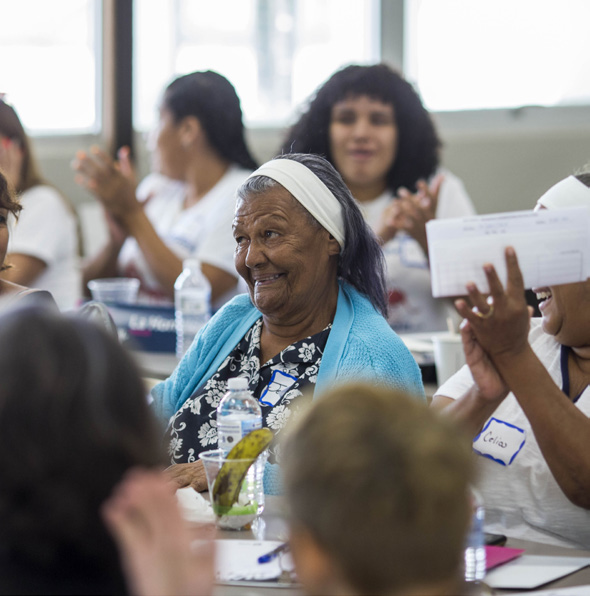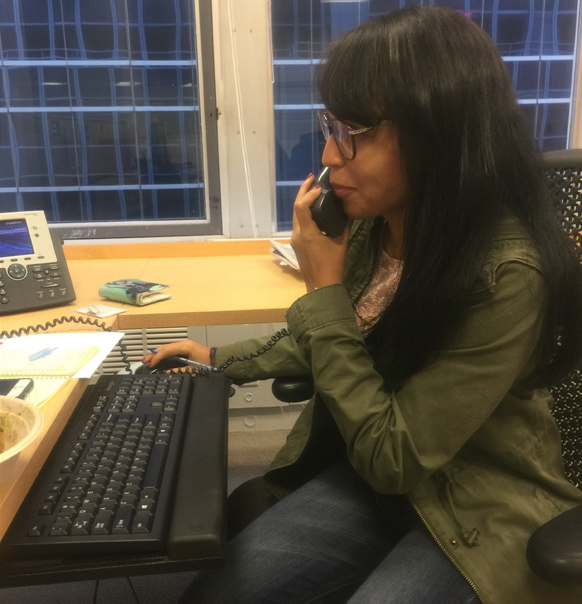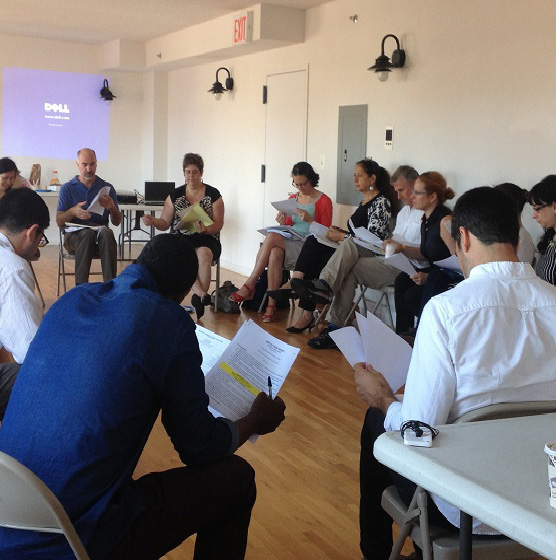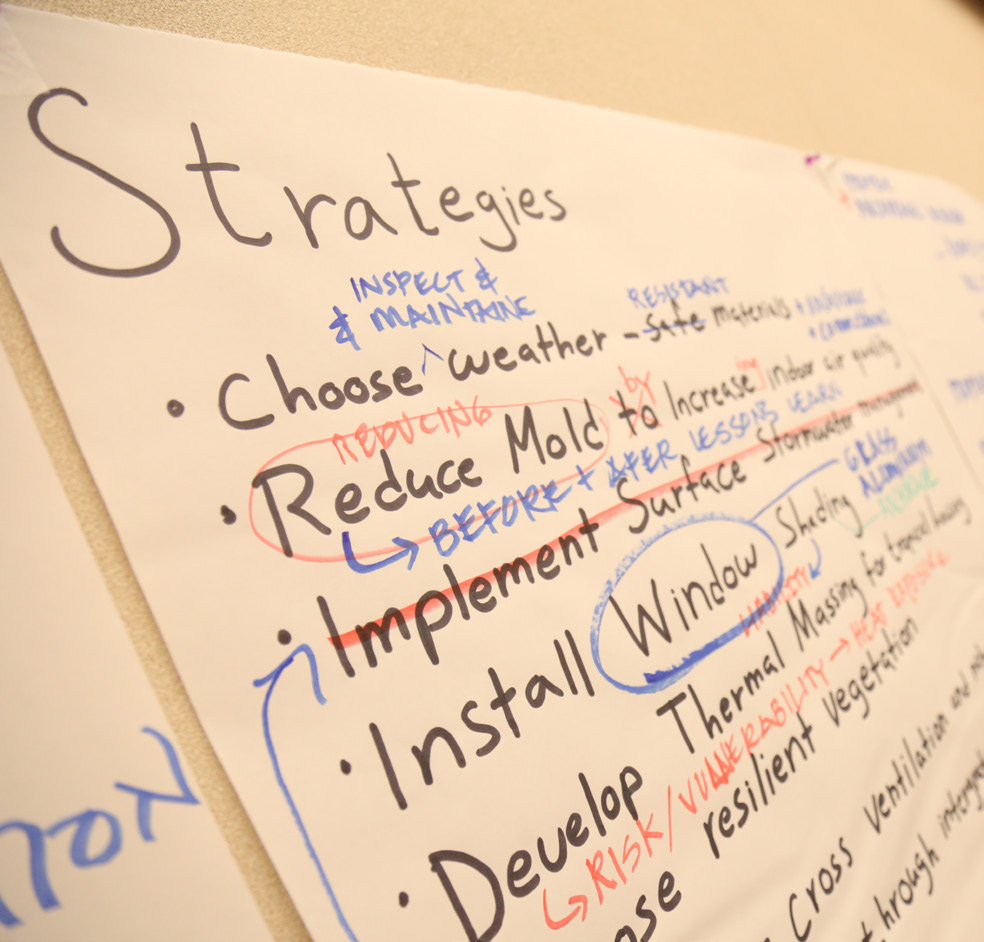INSPIRING POST-DISASTER PLANNING FOR COMMUNITY
| In the event of a natural disaster, having a community plan for emergency response minimizes the risks and allows greater effectiveness in recovery and response processes. This strategy helps create and implement a strategic plan so that your community can continue recovering from its identified immediate needs.The following image describes the interactions of the short- and long-term planning cycle in a community. Long-term preparation efforts support the short-term response. The more a community plans for emergency preparedness, the faster the response and recovery will be. As you can see in the image, this is a cyclical process that proposes mitigation after response as the best way to react towards natural disasters in the future. | Strategy in Action 1. Stage 1 – Response 2. Stage 2 - Recovery 3. Stage 3 - Mitigation and Long-Term Strengthening |
DESCRIPTION + OPERATION
 Ensure the well-being of those who survived the disaster or emergency... first life, then property. The post-emergency plan is divided into two stages:
Ensure the well-being of those who survived the disaster or emergency... first life, then property. The post-emergency plan is divided into two stages:- Stage 1 - Response: it consists of the actions taken when danger is imminent, currently happening, or has just occurred. These actions are meant to save lives, property, and the environment. This stage may include staying in a shelter, ensuring water and food, organizing search parties and rescue teams, providing medical attention to those in need, and creating access to provide help, among other possible activities.
- Stage 2 - Recovery: it consists of actions taken after the response, to bring the community back to its initial state and normal routine as soon as possible. This can include: the reinstatement of essential services, facility and home reconstruction, among others.
- Stage 3 - Mitigation and Long-Term Strengthening: involves enabling community recovery and its long- term improvement through a participatory strategic plan that serves to guide decision making for the benefit of all community members, to improve and resolve the basic needs of the community, and move it towards reaching its collective vision of the desired future.
It is important to understand the stages of the response process to a natural disaster since it starts immediately after the disaster and could take years to be completed. The following image contextualizes the stages of recovery and the time they could take.


STEPS
ESTABLISH A RESPONSE COMMITTEE
DESCRIPTION
- Train people in the community so that they can communicate and respond effectively.
- Certify the members of the committee through the CERT Program (Community Emergency Response Teams) for them to help while government rescue brigades arrive. The program requires candidates to be of legal age and three days of training.

STEPS
COMMUNICATE
DESCRIPTION
Register your community with the local and federal government for post-emergency assistance.
- AEMEAD (Local Government Agency)
The State Agency for Emergency and Disaster Management (AEMEAD, http://www.aemead.pr.gov) is the agency in charge of coordinating all of Puerto Rico's government and private sector resources to provide emergency services as quickly and effectively as possible.
- FEMA (Federal Government Agency)
The Federal Emergency Management Agency (FEMA, www.Disaster Assistance.gov) is a federal government entity that is in charge of organizing emergency help and sheltering assistance in the event of a natural disaster. Notify damages by calling 1-(800) 621-3362 or visiting their webpage.
Remember! It is always important that community members stay informed about location of shelters and how they operate (Strategy 27).

STEPS
DOCUMENT THE DAMAGES
DESCRIPTION
- Document all damages to facilitate communication with emergency agencies, towns and insurance companies.
- Take photos or videos, interview neighbors and highlight the damages on a map.
- Add the effects of every natural disaster to the community profile. This will help you register your community with emergency management agencies.


STEPS
ESTABLISH A PLAN TO MANAGE SOLID WASTE
DESCRIPTION
- Recycle as much as you can to reduce the amount of waste transported to dump sites.
- Identify recycling stations and stockpiling of recyclable waste.
- Do not burn trash for it could be a risk to the community's health and safety.
- Divide your waste to facilitate its management, and group waste such as:
- Vegetative material - trees, branches, leaves, plants (DO NOT place these in bags)
- Recyclable material - plastic, glass, metal, cardboard
- Non-recyclable material - demolition/construction materials (carpets, walls, furniture, wood, mattresses, plumbing material, roofing material, roof tiles, tiles); appliances (air conditioning, fridges, stoves, water heaters); and electronics (computers, televisions, radios and anything that has an electric cable).
- Make sure that waste does not block pedestrian accesses or traffic routes and is not in the way of runoff water or flood-prone areas.
- Contact your municipal administration or garbage collection service to notify that waste is separated and ready for collection.

STEPS
PHYSICAL
DESCRIPTION
- Restore blocked accesses if possible.
- Contact public entities that can help restore essential services.
- Establish a plan for home reconstruction.

STEPS
EMOTIONAL
DESCRIPTION
- Address the psychological and emotional aspects of those who survive a natural disaster.
- Restore normal conditions for young children through collaborative and recreational activities.
- Organize discussion groups to share emotions and provide a positive message.
- If possible, consider setting time and space for relaxation, exercise, or recreation because distractions help manage emotions during difficult times.

STEPS
LONG-TERM
DESCRIPTION
- Use destruction as an opportunity to innovate and create a better future.
- Organize projects that focus on the future as a way to cope with recovery.
- Collaborate with non-profit organizations, educational institutions, and the private sector to find experts and identify funding.

STEPS
ANALYSIS
DESCRIPTION
- In accordance with community organization processes and activities (Strategy 26), it is necessary to lead a discussion to rethink the community's desired future.
- Document priority needs of the physical environment.
- Identify and document hazards and opportunities.
- Recognize, document and share reconstruction and mitigation plans of neighboring communities as well as local, national and federal governments.

STEPS
DIALOGUE
DESCRIPTION
- Facilitate a participatory dialogue that allows the establishment of a strategic plan for your community that includes future projects that will meet the identified needs.
- Document inputs, agreements and dissensions.
- Set priorities by consensus.
- Identify sources of funding to start projects.
- Establish a work schedule.

STEPS
MOBILIZATION AND STRENGTHENING
DESCRIPTION
- Authorize the activation of recovery work committees.
- Develop the necessary supporting documentation to begin with long- term recovery tasks.
- Develop proposals that will allow the commencement of agreed projects.
- Monitor and inform the progress of tasks to keep the community motivated and committed.
- Identify the next generation of community administrators and enable the development of their abilities to achieve sustainable community empowerment.
Centro Comunitario de Caimito offers a safe space to hold community meetings, talks, and cultural events. In addition to being a meeting point for the community, this center provides assistance for families that haven't had their electricity restored yet and offers community health services. The center became an energy source for the future following the installation of solar panels as part of the #EstuarioRevive campaign from the San Juan Bay Estuary Program. This effort was supported by the GivePower Foundation and the Cypress Creek Renewables company. These panels were installed in Centro Comunitario de Caimito in response to the need to pool all efforts in a single place for the benefit of all – efforts that are already underway, although with some difficulties due to the power shortage. This is the only center that provides free community services. This project was made possible by hundreds of people, individual donations, and about a dozen corporate partners across the United States.
For reference: https://www.noticel.com/ahora/centro-comunitario-de-caimito-recibe-panel...

Description: A community that has its own aqueduct and solar energy systems. It runs community centers, gymnasiums, and a community school.
The Corcovada community is located in the municipality of Añasco. For almost 40 years, Corcovada has had its own aqueduct system that provides drinking water to 145 families. The second Saturday of every month, the committee treasurer opens the building (which used to be a school) from 3:00 p.m. to 5:00 p.m. so that residents can pay their water bills. Additionally, efforts were made to secure legislative and municipal funding for the reconstruction of the site of their newly built community center (funds totalled $350,000).
The community began building the center early in 2014, and its foundation stone, a symbol of its inauguration, was placed on Friday, February 21, 2014. This community center has the sole purpose of serving the community by providing a space for events and other services.
For more information, visit https://comitecomunalcorcovada.weebly.com/actividades-y-proyectos.html
 Hogar Albergue offers temporary living arrangements for children who have been victims of abuse, from newborns to 11-year-olds. Hogar provides a safe and positive environment where, aside from providing a loving atmosphere, the following basic needs are met: nutrition, transportation, education, medical care, and cultural activities. Hogar is a 501(c)(3) non-profit organization located in the municipality of Mayagüez.
Hogar Albergue offers temporary living arrangements for children who have been victims of abuse, from newborns to 11-year-olds. Hogar provides a safe and positive environment where, aside from providing a loving atmosphere, the following basic needs are met: nutrition, transportation, education, medical care, and cultural activities. Hogar is a 501(c)(3) non-profit organization located in the municipality of Mayagüez.
INTERVIEW
Interviewee: Hogar Albergue para Niños Jesús de Nazaret, Patricia Valentin and Enactus RUM
Hogar Albergue is a residential space for abused children that have been removed from their homes. Here, children’s basic needs are met, from the newborn stage until they reach 11 years of age. Enactus RUM began collaborating with Hogar because I approached them. Being a professor at the Mayagüez Campus, and as a volunteer of Hogar for many years, I saw the difficulties they faced every day, so I decided to talk with Enactus.
 Hogar prepared for the hurricane just like everyone else, but they obviously did not expect the severity of the event. The administration and staff carefully planned and enacted their emergency plan (as required by law). When we saw the needs and difficulties Hogar faced because of the shortage of drinking water and electricity, as they tried to provide the best conditions possible for the 14 children under their care, we joined forces with Enactus RUM to consider how we could help reduce Hogar’s weekly expenses, which amounted up to $1,000 a week in diesel alone. We also met with United for Puerto Rico and decided to submit a proposal for the installation of a rainwater tank that would make Hogar sustainable for future events like the one we went through. Currently, the tank is installed and connected to the most critical equipment, such as the washing machine and the bathrooms. Besides the tank, and through the efforts of the University of Wisconsin, we are now working on a solar panel system to be installed in the future. Throughout the recovery process, the administration and staff were key participants, especially the “nannies” that stayed with the children during the hurricane. Meanwhile, neighbors also came to Hogar and donated food, water, and gas.
Hogar prepared for the hurricane just like everyone else, but they obviously did not expect the severity of the event. The administration and staff carefully planned and enacted their emergency plan (as required by law). When we saw the needs and difficulties Hogar faced because of the shortage of drinking water and electricity, as they tried to provide the best conditions possible for the 14 children under their care, we joined forces with Enactus RUM to consider how we could help reduce Hogar’s weekly expenses, which amounted up to $1,000 a week in diesel alone. We also met with United for Puerto Rico and decided to submit a proposal for the installation of a rainwater tank that would make Hogar sustainable for future events like the one we went through. Currently, the tank is installed and connected to the most critical equipment, such as the washing machine and the bathrooms. Besides the tank, and through the efforts of the University of Wisconsin, we are now working on a solar panel system to be installed in the future. Throughout the recovery process, the administration and staff were key participants, especially the “nannies” that stayed with the children during the hurricane. Meanwhile, neighbors also came to Hogar and donated food, water, and gas.
For more information, visit: https://hogarjesusdenazaret.org/en/quienes-somos/el-hogar/

 Ensure the well-being of those who survived the disaster or emergency... first life, then property. The post-emergency plan is divided into two stages:
Ensure the well-being of those who survived the disaster or emergency... first life, then property. The post-emergency plan is divided into two stages: